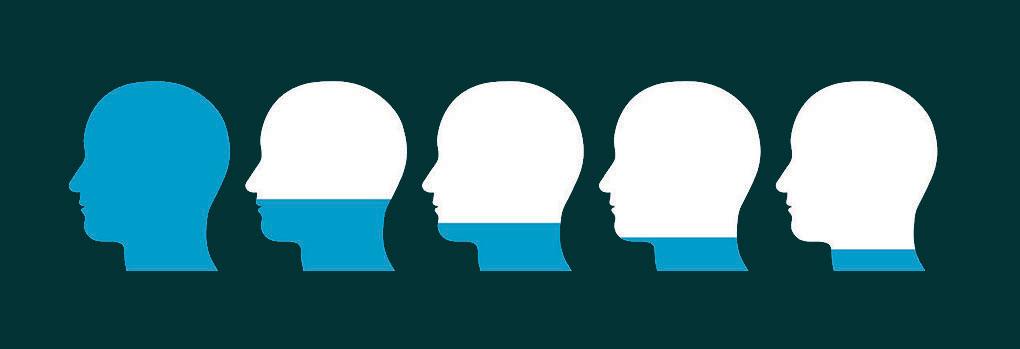We lose about 90% of the information we learn within a month. So you may be investing a lot of money into learning a new skill or training your workforce, when ultimately not much of the material is remembered.
The brain tries to remember important information for survival, for example, if you accidentally touch a flame you automatically retract your hand. To retain other types of information we must persuade our brains that the information is worth remembering and thus overcome the forgetting curve.
In this article we discuss how to overcome Ebbinghaus’ forgetting curve with virtual reality and why it is a valuable training tool.
What is Ebbinghaus’ forgetting curve?
In 1885 the psychologist Hermann Ebbinghaus tested his memory by learning lists of nonsense syllables, such as “WID” and “DIF” and attempted to recall the syllables at particular points in time. Within a few days he had forgotten most of the information and therefore concluded that memory quickly decays.
Subsequently Ebbinghaus created the forgetting curve which shows the rate of forgetting after learning:
- The curve is exponential in nature which means that memory sharply drops from 100% to below 50% in the first few days. Some psychologists say this drop can even occur within the first hour after learning.
- The forgetting rate then continues to decline but at a slower rate.
- Until it plateaus, which was discovered when Ebbinghaus remembered some syllables on one day and then recalled the same syllables on consecutive days.

Factors affecting retention
The forgetting curve can be displayed by this equation:
R = e^(-t/s)
- R – retention is how easily information can be recalled
- t – time passed since the learning has occurred
- s – strength of memory
- e – Euler’s number
Retention depends on:
- The memory’s strength – stronger memories are easier for individuals to recall after longer periods of time compared to weaker memories. Individuals differ in their memories’ strengths.
- How much time has passed since learning – people tend to forget 90% of what they have learned within a few weeks.
Rate of forgetting
The speed of forgetting information can be affected by numerous factors:
- Complexity of the material – the more complicated information is, the quicker it will be forgotten
- How the material is taught – for example, using visual aids, audio, essays, slideshows etc
- How meaningful the information is – this is the extent you can link your learning to previously known concepts. The more relatable the information is, the slower the rate of forgetting
- Physiological factors – such as, lack of sleep or hunger
- Psychological factors – for example, stress or anxiety
Overview: How virtual reality can increase retention
VR lets you practice and improve different skills anywhere, anytime. If you are learning about how to give a sales pitch, you can practice different ways to deliver this pitch over several weeks. This resets the forgetting curve and increases the strength of memory.
Compare this to traditional one or two day training courses. A trainer teaches the group about a certain topic but as soon as the group has left that room, they quickly forget what they have been taught. VR gives employees the chance to reset the forgetting curve through continued practice, helping them with long term retention.
Factors affecting retention and how VR can help
- The memory’s strength – by practicing the skill in a realistic way within VR, the strength of the memory is much higher.
- How much time has passed since learning – with VR, employees can practice different skills at any time – whether that’s in the office or at home. This provides a huge improvement to traditional training workshops or courses.

The forgetting curve with regular practice in virtual reality. Notice how after each practice session, the rate of memory retention increases.
Overcoming the forgetting curve using virtual reality
The forgetting curve can of course be overcome and there are a variety of ways to do this. With the introduction of virtual reality, learning information, procedures and skills for the long-term can now be achieved more effectively compared to traditional methods.
1. Spaced repetition
Ebbinghaus discovered that the forgetting curve declines more gradually if you review information in increasingly larger time gaps. This is called “spaced repetition” and this is how to works:
- Your brain is more likely to label information as important if it has been repeated
- The repetition causes the brain to reconstruct and strengthen memory traces
- The next repetition can be conducted after a slightly longer period of time
- Every time you repeat material your retention goes back to 100%
- Forgetting will start occurring even when you implement spaced repetition but at a significantly decreased rate
- The curve becomes less steep with each review session
- The first repetition should be done within 24 hours after the initial training session
- Over time fewer reviews are necessary
Benefits of virtual reality:
- You can practice as often as you need to within the virtual world as there are no time constraints.
- Learning and practicing can be spaced out in smaller chunks compared to, for example, training days. Information is more likely to be retained if there is gradual learning, rather than being taught an overwhelming amount in a short period of time.
2. Interactive learning
Learning is more effective when you’re more involved and when you are able to practice the skills that have been taught. Recalling material is not the same as or as effective as applying the material, for example, an individual with a fear of public speaking is likely to benefit more from practicing public speaking techniques rather than only reading about the techniques.
Benefits of virtual reality:
- Virtual reality is interactive – you’re interacting with the material and practicing your skills in realistic settings. By practicing in these environments, you will have the opportunity to safely fine-tune your skills and you’re more likely to remember content if you have already applied it.
- It is “experiential learning“, in that you are learning through experience. Research suggests that we learn and recall information effectively when we experience things ourselves rather than being told about concepts or observing. It’s a more efficient way of developing skills.
- Using virtual reality is a more engaging way of learning because it draws your complete attention.
3. More meaningful information
For optimal retention, the information being learned should be relevant to you. By making information more relatable or by linking material to concepts you already know, you are more likely to remember the information.
Benefits of virtual reality:
- By practicing in virtual reality, you are making the material more meaningful and relatable because you are applying the learning in your own way through your responses and behaviour.
- VR environments are highly customisable. For example, you can simulate being interviewed inside a virtual BBC studio and answer questions from the virtual presenter.
4. Importance of medium
Information should be presented in a comprehensive way and therefore easy to understand. For example, staff are less likely to remember the content of a three-page word document on the health and safety regulations of the office, compared to a video of this topic.
Benefits of virtual reality:
- Due to the immersive nature of VR, users remember information more vividly than other content because they are experiencing the learning.
- Virtual reality consists of active recall which means that you’re stimulating your memory while learning. This is beneficial for remembering in the long-term and is more effective than passive recall, such as, re-reading information or just watching a video.
Traditional training has always suffered with the same barriers, limited time, lack of realistic practice, no continued learning etc. Virtual reality is a powerful tool that can get around these issues and overcome the forgetting curve effectively.




